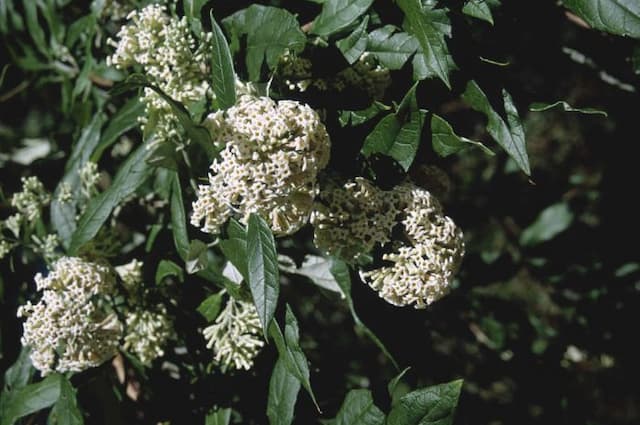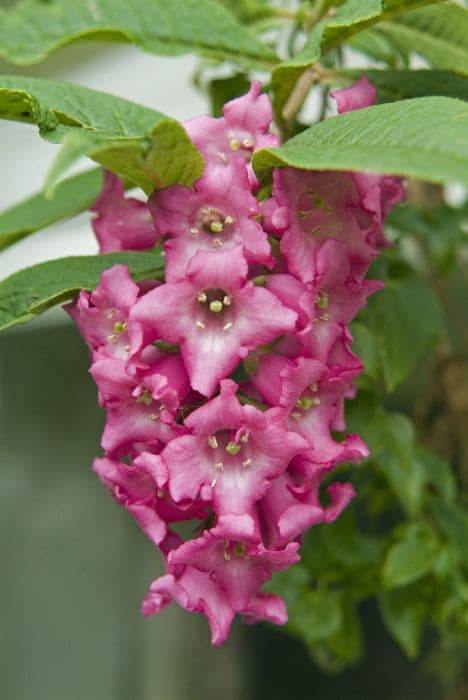Mullein Verbascum 'Brookside'

ABOUT
Verbascum 'Brookside' is a striking plant characterized by a rosette of large, woolly, silvery-green leaves that have a textured surface. From this basal rosette, emerges a sturdy flowering spike, which is densely packed with an abundant number of saucer-shaped flowers. The blossoms come in a beautiful shade of yellow that stands out against the foliage. Each flower features a prominent central stamen, which adds an ornamental touch to the overall appearance of the plant. Verbascum 'Brookside' is attractive to various pollinators, such as bees and butterflies, who are drawn to its vivid blooms. Over time, the plant forms a clump, creating a denser appearance as it spills soft, downy foliage and vibrant flowers into the surrounding space.
About this plant
 Names
NamesFamily
Scrophulariaceae
Synonyms
Mullein, Velvet Plant
Common names
Verbascum 'Brookside'.
 Toxicity
ToxicityTo humans
The mullein plant, commonly known as Verbascum 'Brookside', is generally considered non-toxic to humans. There are no well-documented cases of poisoning from ingesting this plant, and it is often used in traditional herbal remedies. However, as with any plant, individual sensitivities can vary, and consuming any plant in large quantities may cause gastrointestinal discomfort or allergic reactions in some people.
To pets
The mullein plant, commonly known as Verbascum 'Brookside', is not known to be toxic to pets either. While it is unlikely to cause poisoning, ingestion can potentially lead to mild gastrointestinal upset due to the irritation of the digestive tract. Symptoms could include vomiting or diarrhea. If a pet consumes a large amount of any non-food plant, it is advisable to monitor them and consult a veterinarian if any distressing symptoms arise.
 Characteristics
CharacteristicsLife cycle
Perennials
Foliage type
Deciduous
Color of leaves
Green
Flower color
Yellow
Height
6 feet (1.83 meters)
Spread
2 feet (0.61 meters)
Plant type
Herb
Hardiness zones
5
Native area
Europe
Benefits
 General Benefits
General Benefits- Attracts pollinators: Verbascum 'Brookside', commonly known as Mullein, is known to attract bees, butterflies, and other beneficial insects to the garden.
- Drought resistance: Once established, Mullein is quite drought-tolerant, making it suitable for xeriscaping or low-water gardens.
- Architectural interest: With its tall spires of flowers and rosette of leaves, Mullein adds visual interest and a vertical element to the garden landscape.
- Low maintenance: Mullein is generally easy to care for and does not require frequent watering or fertilizing once established.
- Deer resistance: This plant is often left alone by deer, which makes it a good choice for gardens in areas with high deer populations.
- Soil adaptability: Mullein can thrive in a variety of soil types, although it prefers well-drained soil, and can be grown in poor or gravelly soils where other plants might struggle.
- Long blooming period: The flowers of Mullein can bloom for an extended period, often providing color and interest from mid to late summer.
- Easy propagation: Mullein is easily propagated from seed, which can allow gardeners to produce more plants affordably and share with others.
- Cottage garden appeal: Its traditional use in cottage gardens makes it an excellent choice for gardeners looking to create a nostalgic or heritage garden design.
- Seasonal interest: Mullein's foliage and structure can provide interest in the garden even when it's not in bloom, especially during the winter months.
 Medical Properties
Medical PropertiesThis plant is not used for medical purposes.
 Air-purifying Qualities
Air-purifying QualitiesThis plant is not specifically known for air purifying qualities.
 Other Uses
Other Uses- Mulch: Dried leaves from the Verbascum 'Brookside' can be used as mulch to suppress weeds and retain soil moisture.
- Natural Dye: The flowers and leaves of the plant may be boiled to produce yellow or green dyes for fabrics and yarns.
- Livestock Fodder: Though not a common feed, in some cases, the leaves could be used as emergency fodder for livestock.
- Torch Material: Historically, stalks from this plant were dipped in fat and used as torches during processions or rituals.
- Paper Making: The fibrous content of Verbascum stems makes it suitable for adding texture to homemade paper.
- Fire Starter: The downy leaves and dry stalks can serve as kindling to start fires in an outdoor setting.
- Natural Insulation: The felt-like leaves can be used for natural insulation in small structures or bird nests.
- Fish Poison: In some cultures, compounds from the plant were used to temporarily stun fish, making them easier to catch.
- Photographic Material: The flower extract has been used historically in the making of light-sensitive materials for photography.
- Insect Repellent: Some gardeners use the plant as a companion plant to repel certain insects from more valuable plants.
Interesting Facts
 Feng Shui
Feng ShuiThe Mullein is not used in Feng Shui practice.
 Zodiac Sign Compitability
Zodiac Sign CompitabilityThe Mullein is not used in astrology practice.
 Plant Symbolism
Plant Symbolism- Healing: Verbascum plants, also known as Mullein, have been used in traditional medicine, symbolizing the ability to heal and soothe physical ailments.
- Protection: Mullein was once placed in shoes in medieval times to prevent foot injuries, symbolizing protection and safety from harm.
- Courage: With its tall, sturdy spikes that can grow in harsh environments, Mullein can be seen as a symbol of courage and resilience.
- Purity: The light-colored flowers of the Verbascum 'Brookside' can represent purity and innocence.
 Water
WaterFor the common mullein, which is the most common name for Verbascum 'Brookside', ensure the plant receives deep watering less frequently rather than shallow watering more often to encourage a strong root system. Allow the top inch of the soil to dry out between waterings, and then water thoroughly until excess water drains out. In the growing season, this might translate to approximately every 7 to 10 days, but always adjust according to weather conditions—more frequent waterings during hot, dry periods and less during cool, damp periods. A good rule of thumb is to provide about one to two gallons per plant during each watering session, ensuring you're reaching the deeper roots without overwatering.
 Light
LightThe common mullein thrives in full sun conditions, requiring at least 6 to 8 hours of direct sunlight daily for optimal growth and flowering. It’s best to place the plant in a spot where it can receive the early morning and afternoon sun without any shade interference. Partial shade is acceptable but may result in fewer flowers and less vigorous growth.
 Temperature
TemperatureCommon mullein prefers temperate conditions and can survive winters in areas where temperatures do not typically drop below 20 degrees Fahrenheit. Its ideal growing range is between 60 to 85 degrees Fahrenheit, with growth slowing down significantly if the temperature rises above 90 degrees Fahrenheit or falls below the survival threshold. The plant is quite hardy but may require protection or mulching if exposed to extreme cold conditions.
 Pruning
PruningPruning the common mullein involves deadheading spent flowers to encourage additional blooming and to prevent self-seeding if not desired. It's also beneficial to remove any damaged or diseased foliage to maintain plant health. Pruning should be done after the first flush of flowers has faded, usually in the mid to late summer. If the plant becomes too large or woody, it can be cut back in the late fall or early spring.
 Cleaning
CleaningAs needed
 Soil
SoilMullein, commonly known as Verbascum 'Brookside', thrives best in well-draining, moderately fertile soil with a pH range of 6.0 to 8.0. A mix composed of two parts loam, one part sand or perlite, and one part compost or well-rotted manure will provide a balanced structure that promotes healthy growth. Sufficient drainage prevents root rot and supports the mullein's preference for drier conditions.
 Repotting
RepottingMullein, known as Verbascum 'Brookside', generally does not require frequent repotting and should be repotted every 2 to 3 years. The best time to repot is during the spring, and it's important to move the plant to a slightly larger container with fresh, well-draining soil mix to promote healthy growth.
 Humidity & Misting
Humidity & MistingMullein, or Verbascum 'Brookside', is tolerant of a wide range of humidity levels but prefers dryer air typical of its natural habitat. It does not have high humidity requirements, making it suitable for most indoor environments without the need for additional humidity control.
 Suitable locations
Suitable locationsIndoor
Place in bright, indirect light and water sparingly.
Outdoor
Full sun, water moderately, protect from strong winds.
Hardiness zone
5-9 USDA
 Life cycle
Life cycleThe Brookside Mullein or Verbascum 'Brookside', begins its life as a seed, which germinates in warm soil with adequate sunlight and moisture, emerging as a seedling with characteristic fuzzy leaves. It then develops into a rosette of leaves staying close to the ground during its first year, in a vegetative state, typically as a biennial. In its second year, the plant elongates to produce a tall flowering stalk, with flowers that are usually yellow, blooming in succession up the stalk throughout the summer. After the flowering period, seeds are produced and dispersed from the dried flowers, ensuring the next generation of plants. Following seed dispersal, the Brookside Mullein completes its life cycle and typically dies, having reached the end of its biennial life span. Some plants can behave as short-lived perennials, depending on environmental conditions, and may re-sprout from the base to flower in subsequent years before eventually dying.
 Propogation
PropogationPropogation time
Early spring
The most popular method of propagating the Verbascum 'Brookside', commonly known as Mullein, is through seed sowing. Seeds can be sown in late winter to early spring, typically indoors to protect them from the cold. Once sown lightly on the surface of a well-draining seed starting mix, they need exposure to light to germinate, which usually takes about two to three weeks at a temperature of 65 to 70 degrees Fahrenheit (approximately 18 to 21 degrees Celsius). The seedlings should be kept moist but not waterlogged. When they have grown strong enough and the threat of frost has passed, the young plants can be transplanted outside into a sunny location with well-draining soil. This method is favored for its simplicity and effectiveness in producing new plants that are true to the parent’s characteristics.

![Butterfly bush [Berries and Cream]](/_next/image?url=https%3A%2F%2Fplants-admin.emdemapps.com%2Fimages%2Fplants%2F%2Fimages%2F604b650f667be.png&w=640&q=75)





![Butterfly bush [Nanho Purple]](/_next/image?url=https%3A%2F%2Fplants-admin.emdemapps.com%2Fimages%2Fplants%2F%2Fimages%2F604b5e3cb2c58.png&w=640&q=75)
